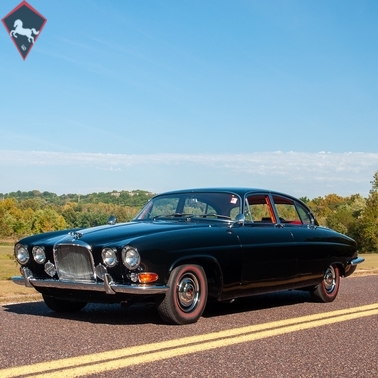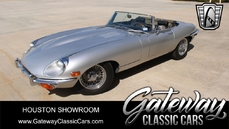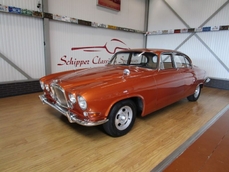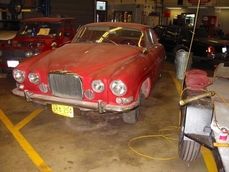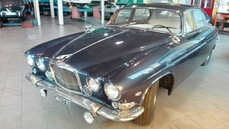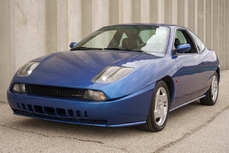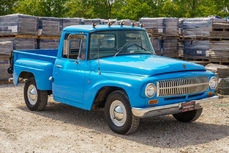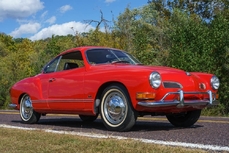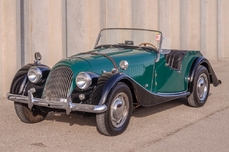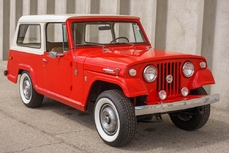Jaguar MK X 3.8L straight six 1964
Allgemeine Beschreibung :
1964 Jaguar Mark X Saloon
Previously owned/titled by real estate mogul Richard Parkoff of the Parkoff Organization
Parkoff commissioned a no expense spared restoration on this Mark X in Southern Florida
One of 5,775 Mark Xs exported in 1964
First Jaguar Saloon to feature independent rear suspension
Black exterior with rich red leather interior
3.8L inline six-cylinder engine with triple SU carburetors
Borg-Warner DG 250 three-speed automatic transmission and 3.54 gearing
Air-conditioning, power steering, power four-wheel disc brakes and power windows
Rear seats feature fold-down trays and fold-down center armrest
Redline Coker Classic tires to match the red interior
Comes with Jaguar Daimler Heritage Trust certificate
Own this Vehicle from $639 per month-call 636-600-4600
Seeking a classic British Executive Luxury Saloon finished in desirable black exterior and rich red leather interior that has benefited from a no expense spared extensive restoration by Mr. Executive himself, real estate tycoon Richard Parkoff! MotoeXotica Classic Cars is pleased to present this handsome 1964 Jaguar Mark X Saloon.
Made on March 16, 1964 at Jaguar’s Coventry, England factory, . It was dispatched on April 7, 1964 via Jaguar Cars in New York, NY. With the most recent owner being Richard Parkoff of the Parkoff Organization, a massively successful New York City real estate firm. In 2008 the Parkoff Organizaion making headlines with New York City’s largest ever all-cash deal in real estate. Since then the organization has made multiple other multimillion dollar deals in and around New York City. Making the Parkoff Organization one of the premier real estate firms in New York City.
With money being no object, about 10 years ago, the car was repainted and reupholstered – the exterior is finished in a stunning black exterior while the interior is finished in rich red leather that absolutely smells wonderful. The paint and trim are in excellent overall condition. The windows are clear and intact while the car’s lights are haze-free and intact. The car’s bodywork is straight and solid including the chrome bumpers.
The area under the bonnet (hood) is extremely tidy, the battery appears new while the boot (trunk) is in very good overall condition, complete with full-sized spare tire and cover. This classic cat rolls on Coker Classic redline tires, size P195/70R14 at all four corners and each tire is mounted on a steel wheel topped with factory wheel cover. The tires and wheel covers are all in very good order.
Under the hood is Jaguar’s venerable 3.8L straight six motor breathing via triple SU carburetors and dual exhausts and backed by a Borg-Warner DG250 three-speed automatic transmission and a 3.54:1 rear end. Driver convenience features include air-conditioning, power steering, power four-wheel disc brakes and power windows.
Inside, the car’s red leather interior is quite eye-catching and complements the exterior well. The supple leather is very inviting and the burled walnut accents on the door panels, instrument panel and center console inject warmth. The front and rear seats are in excellent shape, as is the matching carpet. The factory two-spoke steering wheel is present and looks great. The dashboard and inner door liners are in nearly impeccable condition. Even the center console looks fantastic. The interior was Jaguar’s last to feature abundant standard woodwork, including the dashboard, escutcheons, window trim, a pair of large bookmatched fold out rear picnic tables, and a front seat pull-out picnic table stowed beneath the instrument cluster.
The Jaguar Mark X (Mark Ten) was British manufacturer Jaguar’s top-of-the-range saloon for a decade, from 1961 to 1970. The large, luxurious Mark X succeeded the Mark IX as the company’s top saloon model and was primarily aimed at the United States market. The company hoped to appeal to heads of state, diplomats and film stars.
Introduced in the same year as Jaguar’s iconic E-Type, the Mark X impressed with its technical specification and innovations. Contrary to its predecessors, the car featured integrated, unitary bodywork – the largest in the UK at the time, as well as independent rear suspension, unheard for early 1960s British luxury cars. Combined with the 3.8-litre, triple carburetor engine as fitted to the E-type, it gave Jaguar’s flagship a top speed of 120 mph and capable handling at less than half the price of the contemporary Rolls-Royce Silver Cloud.
Despite press acclaim from both sides of the Atlantic, the Mark X never achieved its sales targets. When Jaguar decided to replace its entire saloon range with a single new model, the resulting XJ6 of 1968 used the Mark X as a template – albeit with a reduced size.
In 1961, the Mark X introduced a new upright, and slightly forward-leaning nose design for Jaguar saloons, with four headlamps set into rounded front fenders (derived from Daimler DK400), and a vaned grill. This front-end style reappeared on many of the manufacturer’s successive saloons, up to and including the X-Type and third generation Jaguar XJ, both through 2009 — thereby forging Jaguar saloons’ look for half of a century. In 2008, Jalopnik called the quad round headlight design the classiest headlight configuration and the fourth-best car design element of all time, mentioning Jaguar specifically.
Instead of relying on body-on-frame construction, like its predecessors and most of its competitors, the Mark X received a unitary construction monocoque body-shell, codenamed “Zenith” during its development. The substantial doors required helical torsion springs inside the door pillars to enable them to be opened from the inside with a low level of effort.
From its introduction in mid-October 1961 until the arrival in 1992 of the low-slung XJ220, the Mark X stood as one of the widest production Jaguars ever built. Asked in 1972 if he thought the Mark X had grown too large, Jaguar chairman William Lyons agreed that it “definitely” had: he opined that the then recently introduced and notably more compact Jaguar XJ6 was, by contrast an “ideal size.”
The Mark X was the first Jaguar saloon to feature independent rear suspension. It differed from earlier large Jaguar saloons in having 14” wheels instead of the more common 15”. It used a wider-track version of Jaguar’s IRS unit first seen on the E-Type, which was subsequently used on Jaguar vehicles until XJ-S production ended in 1996. The front suspension used double wishbones with coil springs and telescopic dampers.
Power initially came from the E-type’s version of Jaguar’s XK inline six-cylinder engine. A 9:1 compression ratio was standard but an alternative 8:1 compression ratio was available as an option. Triple SU carburetors were fitted, fed from an AC Delco air filter mounted ahead of the right-hand front wheel.
Transmission options were manual, manual with overdrive, automatic, or automatic with overdrive. Many domestic market cars and all cars destined for the important North American markets left the factory with a Borg Warner automatic gearbox.
Stopping power for this heavy car came from power-assisted disc-brakes on all four wheels and power-assisted steering was standard.
Documentation includes a Jaguar-Daimler Heritage Trust Certificate and more than $4K in receipts from Mr. Parkoff’s restoration in Florida.
Competition to this Jaguar in 1964 included BMW’s New Class Sedan, Cadillac’s Sedan de Ville, Chrysler’s 300, Mercury’s Park Lane, Oldsmobile’s 98 and Mercedes-Benz’s 600.
Whether you’re a head of state, diplomat or a movie star or not, you should visit MotoeXotica Classic Cars to check out this classic, full-size Jaguar. You won’t see many ‘60s Jaguars on the road, at the car show or cruise night.
VIN: 353588BW EIN: ZB4067-9 TIN: JX10518P BIN: Z13124
This car is currently located at our facility in St. Louis, Missouri. Current mileage on the odometer shows 53,813 miles. It is sold as is, where is, on a clean and clear, mileage exempt title. GET OUT AND DRIVE!!!
Copy & Paste the Link Below to View Our YouTube Video:
https://youtu.be/38DYlGgGRbM
https://www.motoexotica.com/inventory/listing/1964-jaguar-mark-x/
1964 Jaguar MK X 3.8L straight six is listed verkauft on ClassicDigest in Fenton (St. Louis) by for $42900.
Fakten der Auto
Karosserietyp : Auto Marke : Jaguar Modell : MK X Ausführung : 3.8L straight six Hubraum : 3.8 Modelljahr : 1964 Karosstyp : Sedan Lage : Fenton (St. Louis)
Verkauft
Angaben Zum Verkäufer
Verkauft
People who viewed this Jaguar MK X also viewed similar Jaguar listed at ClassicDigest
Other cars listed for sale by this dealer
über Jaguar
Ah, die Geschichte von Jaguar, von seinen Anfängen als SS Cars Ltd. bis hin zum Höhepunkt mit dem D-Typ und der Straßenversion des ikonischen E-Typs. An dieser Erzählung haftet etwas zutiefst Britisches, und ich werde sie erzählen, wie es ein britischer Journalist tun würde.Die Anfänge:
Unsere Reise in die Welt von Jaguar beginnt in den 1930er Jahren, als ein Unternehmen namens SS Cars Ltd. auftauchte. Trotz des unglücklichen Zufalls ihrer Initialen, die mit den aufkommenden politischen Spannungen in Europa zusammenfielen, begannen sie, stilvolle und leistungsorientierte Autos herzustellen. Der SS 100, der 1936 eingeführt wurde, war ein Symbol für Eleganz und Geschwindigkeit und legte den Grundstein für das, was Jaguar werden sollte.
Die Geburt von Jaguar:
Als der Schatten des Zweiten Weltkriegs näher rückte, entschied sich SS Cars Ltd. klugerweise, sich von den SS-Initialen zu distanzieren. So wurden sie 1945 offiziell zu Jaguar Cars Ltd., ein Name, der bald für britischen Luxus und Leistung stehen würde.
Die XK-Serie:
Die Nachkriegszeit von Jaguar brachte uns den XK 120, eine wahre Sensation im Jahr 1948. Mit seinem schlanken Design und einem leistungsstarken 3,4-Liter-Sechszylindermotor wurde er zum schnellsten Serienauto der Welt. Der XK 120 war die Blaupause für das, was kommen würde - Jaguars, die Stil mit Geschwindigkeit auf einzigartig britische Weise verbanden.
Die Dominanz des D-Typs:
Dann kam der D-Typ, eine wahre Rennlegende. 1954 eingeführt, gewann er in den 1950er Jahren dreimal Le Mans und zeigte die technische Kompetenz von Jaguar. Mit seiner innovativen Monocoque-Konstruktion und der ikonischen Finne hinten war der D-Typ der Höhepunkt von Jaguars Motorsporterfolgen.
Das Auftauchen des E-Typs:
Aber der wahre Wendepunkt kam 1961 mit der Einführung des E-Typs, oft von Enzo Ferrari als "das schönste Auto, das je gebaut wurde" bezeichnet. Seine lange Motorhaube, die geschwungene Karosserie und ein 3,8-Liter-Motor, der atemberaubende Leistung lieferte, machten ihn sofort zu einem Klassiker. Der E-Typ war nicht nur ein Auto; er war ein Kunstwerk auf Rädern und konnte auf der Straße 150 Meilen pro Stunde erreichen.
Straßen- und Rennsporterfolge:
Die Schönheit des E-Typs wurde durch seine Leistung auf der Rennstrecke unterstrichen. Die leichten E-Typen waren bei verschiedenen Rennveranstaltungen besonders erfolgreich und festigten den Ruf von Jaguar als eine Kraft, mit der man im Motorsport rechnen musste.
Das Zeitalter der Raffinesse:
Je tiefer wir in die Geschichte von Jaguar eintauchen, desto mehr erkennen wir, dass die 1950er und 1960er Jahre ein Zeitalter der Raffinesse und Expansion waren. Neben dem großartigen D-Typ und dem ikonischen Aufstieg des E-Typs führte Jaguar Modelle ein, die seinen Ruf für Luxus und Leistung weiter festigten.
Der MK2:
Ende der 1950er Jahre stellte Jaguar den MK2 vor, eine Sportlimousine, die Eleganz mit Leistung vereinte. Diese elegante viertürige Limousine war sowohl bei Bankräubern als auch bei der Polizei aufgrund ihrer außergewöhnlichen Geschwindigkeit und Handhabung beliebt. Der MK2 war ein Symbol für Jaguars Fähigkeit, Raffinesse mit Leistung zu verbinden und hatte auch eine erfolgreiche Rennkarriere.
Der XJ6:
Springen wir ins Jahr 1968, als Jaguar ein Auto auf den Markt brachte, das Jahrzehnte lang Luxuslimousinen definieren würde - den XJ6. Es war ein Meisterwerk der Ingenieurkunst und des Designs, mit einem sanften Reihensechszylindermotor, unabhängiger Hinterachse und einem geräumigen, wunderschön ausgestatteten Innenraum. Der XJ6 war ein Symbol britischer Eleganz und bot eine so sanfte Fahrt, dass es schien, als würde er förmlich über die Straße gleiten. Er wurde zum Flaggschiffmodell für Jaguar und setzte den Maßstab für Luxuslimousinen und zeigte ein Maß an Raffinesse, das die Konkurrenz staunen ließ.
Die Verschmelzung von Klassik und Moderne:
Während der MK2 und der XJ6 die Evolution der Limousinen von Jaguar repräsentierten, bewahrten sie das Engagement der Marke für Leistung und Luxus. Diese Autos gehörten nicht nur auf die Rennstrecke; sie fühlten sich genauso wohl auf den Prachtstraßen wie auf einer entspannten Fahrt durch die englische Landschaft.
Die Herausforderungen des Wandels:
Dennoch sah sich Jaguar mit dem Eintritt der 1970er Jahre, wie viele britische Automobilhersteller, finanziellen Herausforderungen und Veränderungen in der Eigentümerschaft gegenüber. Die Ära von British Leyland brachte sowohl Chancen als auch Schwierigkeiten mit sich, während die Marke durch verschiedene Fusionen und Übergänge navigierte.
Das Erbe des MK2 und des XJ6, zusammen mit dem D-Typ und dem E-Typ, definiert Jaguar weiterhin als einen Hersteller, der zeitlose Eleganz mit einer Leistungsstärke vereint. Diese klassischen Modelle, ob sie über kurvige Straßen gefahren oder als Sammlerschätze geparkt werden, dienen als Zeugnis für die anhaltende Präsenz von Jaguar in der Welt der automobilen Exzellenz.
Die Jaguar-Geschichte, von ihren Anfängen als SS Cars Ltd. bis zur Schaffung von Automobilikonen wie dem E-Typ, dem MK2 und dem XJ6, ist eine Reise, die das Wesen des britischen Automobilbaus widerspiegelt - eine Mischung aus Luxus, Leistung und Stil, die nach wie vor Enthusiasten und Kenner gleichermaßen fasziniert.
